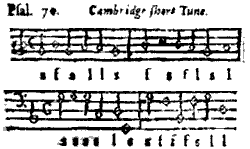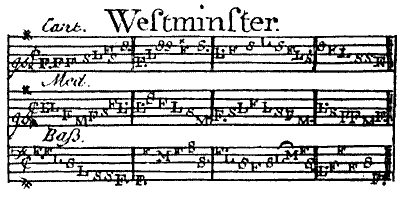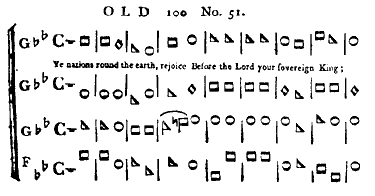
Cambridge Short tune from the Bay Psalme Book, 1698,
melody and bass, with mi-fa-sol-la letters printed beneath the staff.
The diamond shaped notes were standard musical
notation at that time.
Solfege is a method of ear-training which uses the assignment of syllables to degrees of the scale to assist a singer's memory of pitch. The European hexachord (six note) system of Ut - Re - Mi - Fa - Sol - La was codified by Guido d'Arezzo (990 - 1055) and used for hundreds of years. Since the hexachord consists of only six notes, it is necessary to overlap hexachords to cover a full octave:
ut re mi fa sol la
ut re mi fa sol la
ut re mi fa sol la
G A B C D E F G A B C D E
There were rules to determine from which hexachord the syllable for
a given note would be sung.
The continental six-note Ut-Re-Mi was simplified in England
to the
four-note system which you can see above by following the scale from
C to C as Fa - Sol - La - Fa - Sol - La - Mi - Fa.
This is what the English colonists brought with them when they set sail for
the New World, and upon which the early New England singing masters
based their lessons.
...I have caused a new print of note to be made with letter to be joined to every note: whereby thou mayest know how to call every note by his right name, so that with a very little diligence thou mayest more easilie by the viewing of these letters, come to the knowledge of perfect solfeying... the letters be these U for Ut, R for Re, M for My, F for Fa, S for Sol, L for La. Thus where you see any letter joyned by the notes you may easilie call him by his right name, ...Across the ocean and a century later at Boston in 1698 the ninth edition of the Bay Psalme Book (printed since 1640 with texts only) featured the addition of 13 two-part tunes, with four-note syllables indicated by letters printed beneath the staff. This is thought to be the first music printed in the New World.

Cambridge Short tune from the Bay Psalme Book, 1698,
melody and bass, with mi-fa-sol-la letters printed beneath the staff.
The diamond shaped notes were standard musical
notation at that time.
Rev. John Tufts
An Introduction to the Singing of Psalm-Tunes
in a Plain & Easy Method
first appearing between 1714 and 1721
had the further innovation of printing the initial letters (M-F-S-L)
on the staff in place of the note-heads.
Durations are indicated by the extra dots to the right of the letter -
each dot doubles the length of the note.

Westminster, in three parts with new notation by John Tufts.
Printed in Boston. From the edition of 1727.
Andrew Law's The Musical Primer of 1803, used similar shaped notes but interchanged somewhat from the assignments of Smith & Little and without the customary five-line staff.

By 1815 in Boston the fuguing tunes, shape-notes and the fa-sol-la solmization that facilitated them had become (so the reformers thought) obsolete and interest in them was maintained primarily to the far south and west.
In these parts of the country though, the hymns and music were taken to heart and survive to this day. One such example is William Walker's Southern Harmony, first printed in New Haven in 1835, revised several times and there are those who still sing from a current printing of a facsimile editions of the version of 1854. Another is Benjamin Franklin White's Sacred Harp, first published in 1844, most recently revised in 1991.
Tunes are sung in relative pitch, rather than at an absolute pitch derived from A=440; referred to as " Pitch of Convenience", a long standing tradition as can be seen from directions for setting the first Note from the Bay Psalm Book.